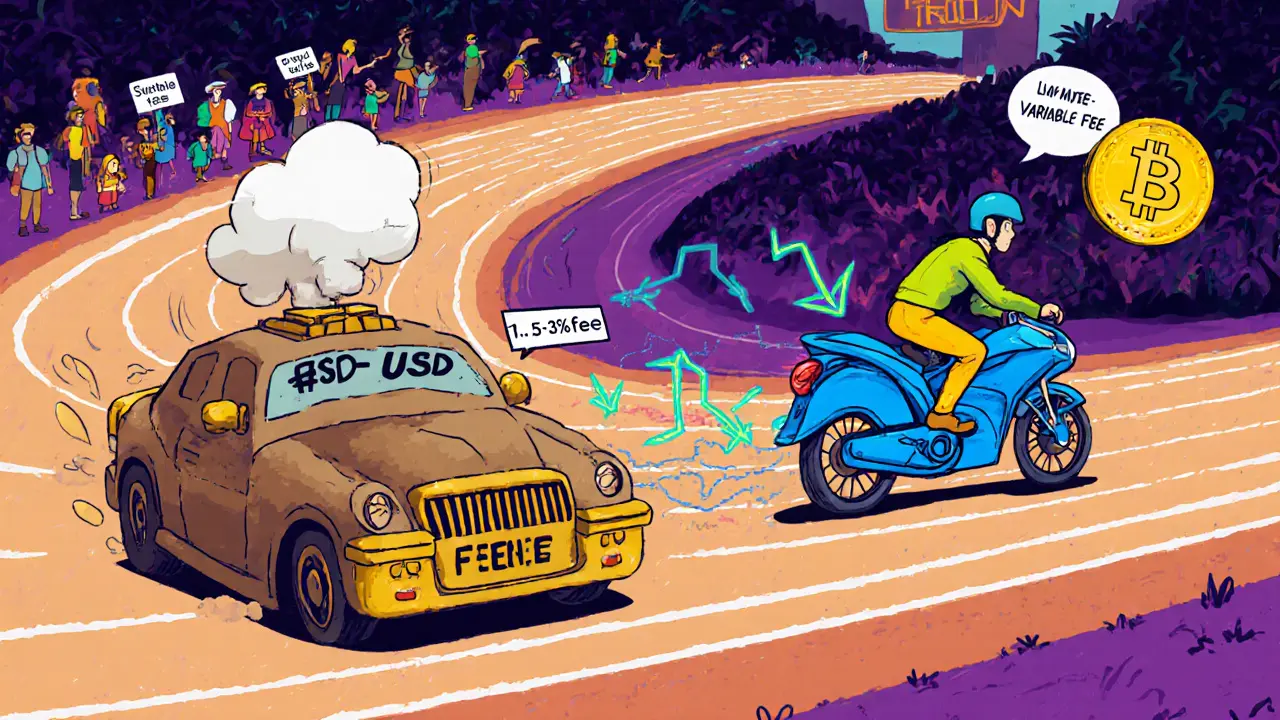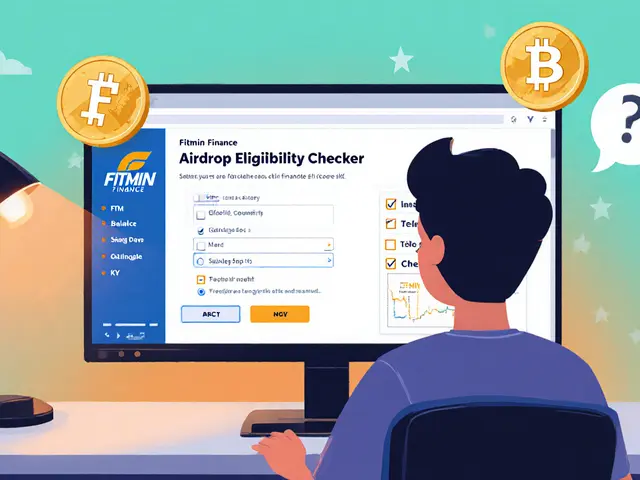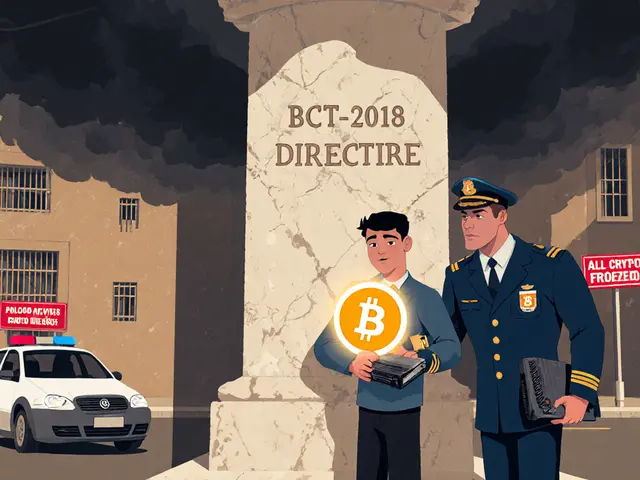Digital vs. Fiat Currency Comparison Tool
This interactive tool highlights the fundamental differences between digital currencies (like Bitcoin and Ethereum) and traditional fiat currencies (such as USD, EUR, and JPY). Select an attribute below to see detailed comparisons.
| Attribute | Fiat Currency | Digital Currency |
|---|
Understanding the Differences
Fiat currencies are government-backed and regulated, offering stability and widespread acceptance. Digital currencies are decentralized, often limited in supply, and operate on blockchain technology with faster cross-border capabilities.
While digital currencies offer potential for innovation and global accessibility, they come with higher volatility and regulatory uncertainty. Fiat currencies provide predictability and legal protections but may lack the efficiency of digital systems.
When you hear the terms digital currency and fiat money tossed around in the news, you might wonder how they really differ. Both are used to buy coffee, pay rent, or send money abroad, yet they sit on opposite sides of a technological and governance divide. This guide walks you through the core contrasts, from who controls the supply to how transactions get settled, so you can decide which fits your needs today.
What Exactly Is a Digital Currency?
Digital Currency is a type of money that exists only in electronic form. It relies on cryptographic algorithms and a distributed ledger-usually a blockchain-to record ownership and validate transfers without a central authority. Popular examples include Bitcoin, the first cryptocurrency launched in 2009, and Ethereum, which adds programmable smart contracts.
What Is Fiat Currency?
Fiat Currency refers to government‑issued money that has value because the state declares it legal tender and backs it with its credit. Think of the US dollar, euro, British pound, or Japanese yen. Central banks-like the Federal Reserve in the United States-manage the supply, set interest rates, and intervene in markets to keep prices stable.
Control and Governance: Centralized vs. Decentralized
Fiat money lives under a single, identifiable authority. A Central Bank can print new notes, adjust reserve requirements, or enact quantitative easing based on its assessment of the economy.
Digital currencies, on the other hand, are governed by code. In Bitcoin, the total supply caps at 21 million coins and the network follows a Proof‑of‑Work (PoW) consensus where miners solve cryptographic puzzles to add blocks.
Ethereum’s shift to Proof‑of‑Stake (PoS) lets validators lock up tokens as collateral, reducing energy use while still preventing fraud.
Supply Dynamics: Unlimited vs. Finite
Governments can expand fiat money supply at will. This flexibility helps fight recessions but also opens the door to inflation-or in extreme cases, hyperinflation, as seen in Zimbabwe’s 2015 crisis where a 100‑trillion‑dollar note bought only about 40 US cents.
Most cryptocurrencies embed scarcity in their protocols. Bitcoin’s 21‑million limit and Ethereum’s annual issuance cap create a predictable, often deflationary, monetary environment.
Physical vs. Purely Electronic
Fiat cash still exists as paper bills and metal coins, useful in areas with limited internet access. Digital fiat, such as bank deposits or credit‑card balances, lives electronically but is always anchored to a physical legal‑tender system.
Digital currencies have no physical counterpart. Their entire existence is a set of encrypted entries on a blockchain, making counterfeiting virtually impossible.
Transaction Speed and Cost
Domestic fiat payments-think swipe‑card or online ACH-settle within seconds but usually incur merchant fees ranging from 1.5% to 3%.
Cross‑border fiat transfers may take several business days and involve multiple intermediaries, each adding a markup.
Cryptocurrency transfers can clear in minutes to a few hours, regardless of geography. Fees fluctuate with network demand; a Bitcoin transaction might cost $2‑$10, while an Ethereum smart‑contract operation could be a few dollars.
Volatility and Price Stability
Because central banks actively manage monetary policy, fiat currencies enjoy relatively low price swings-an essential trait for everyday commerce and long‑term budgeting.
Digital assets are notoriously volatile. Bitcoin’s price has swung more than 80% in a single year multiple times, making it risky as a primary spending medium but attractive as a speculative store of value.

Regulation and Legal Protections
Fiat money benefits from clear legal frameworks, consumer protection laws, and dispute‑resolution mechanisms. If a credit‑card charge is fraudulent, banks often reverse it.
Cryptocurrencies operate in a patchwork of regulations. Some jurisdictions ban them outright; others, like the EU with its MiCA rules, are crafting comprehensive guidelines. Lost private keys result in permanent loss-no insurance, no recourse.
Security Risks: Theft vs. Key Management
Physical cash can be stolen, but theft is usually reported to law enforcement, which can recover it if caught.
Digital fiat transactions rely on bank‑level security, including encryption, fraud monitoring, and insurance. Cryptocurrency security hinges entirely on how you store your private keys. A misplaced recovery phrase means the assets are gone forever.
Emerging Hybrid: Central Bank Digital Currencies (CBDCs)
Many central banks are experimenting with Central Bank Digital Currency (CBDC), a digital version of fiat money that aims to combine the stability of government backing with the speed of blockchain‑like settlement. China’s digital yuan and the EU’s digital euro pilot are early examples. CBDCs could eventually blur the line between traditional and digital money, but they remain under tight government control.
Side‑by‑Side Comparison
| Attribute | Digital Currency | Fiat Currency |
|---|---|---|
| Issuer | Decentralized network (no single authority) | Government & Central Bank |
| Supply Model | Fixed or algorithmically limited (e.g., 21M BTC) | Unlimited - can be printed or minted at will |
| Physical Form | None - 100% electronic | Notes, coins, and electronic balances |
| Transaction Speed | Minutes to hours (depending on blockchain) | Seconds domestically, days internationally |
| Typical Fees | Variable - from a few cents to $10+ | 1.5%-3% for card payments; higher for wire transfers |
| Volatility | High - price can swing >50% in weeks | Low - stable within <1% daily |
| Regulatory Status | Emerging, jurisdiction‑dependent | Well‑established legal tender |
| Security Model | Cryptographic keys; user‑managed | Bank‑level encryption & fraud protection |
| Privacy | Pseudonymous - wallet address only | Traceable via banking records |
Practical Use Cases
- Cross‑border payments: A freelancer in Wellington can receive Bitcoin from a client in Brazil within an hour, bypassing SWIFT fees.
- Daily purchases: Most grocery stores still require fiat money or card payments; few accept crypto directly.
- Store of value: In inflation‑hit economies, citizens sometimes turn to Bitcoin as a hedge, despite its price swings.
- Programmable finance: Smart contracts on Ethereum enable automated escrow, insurance payouts, and decentralized finance (DeFi) services.
Common Pitfalls to Avoid
- Assuming crypto is risk‑free because it’s decentralized. Market volatility and hacking incidents prove otherwise.
- Ignoring tax obligations. Many countries treat crypto gains as taxable events.
- Storing private keys on unsecured devices. Use hardware wallets or reputable custodial services.
- Relying on a single blockchain. Different networks offer varying speed, cost, and security profiles.
How to Choose the Right Tool for Your Needs
If you need predictable pricing for everyday expenses, stick with fiat or a CBDC once it’s available. For international transfers where speed and cost matter, evaluate stablecoins (e.g., USDC) or major cryptocurrencies with low fees. For speculative investment or hedging against local inflation, consider allocating a modest portion of your portfolio to Bitcoin or Ethereum, but be prepared for price swings.
Future Outlook: Coexistence, Not Competition
Analysts agree that digital currencies will not replace fiat outright. Instead, we’ll see hybrid ecosystems: traditional banks offering crypto custodial services, governments launching CBDCs, and merchants accepting both forms. The key is understanding each system’s strengths and limits so you can leverage them wisely.

Frequently Asked Questions
Is Bitcoin considered a digital currency or a cryptocurrency?
Bitcoin is both. It is a type of digital currency because it exists only electronically, and it is the first cryptocurrency because it uses cryptographic proof‑of‑work to secure the network.
Can I use a cryptocurrency to pay my rent today?
Only if your landlord accepts crypto directly or you use a payment gateway that converts it to fiat on the fly. Adoption is growing but remains limited compared with traditional payment methods.
What are the main security risks of holding fiat versus crypto?
Fiat can be stolen physically or through fraud, but banks usually offer dispute resolution and insurance. Crypto security hinges on private‑key management; loss or theft of keys means permanent loss, with no recourse.
How do central bank digital currencies differ from Bitcoin?
CBDCs are issued and controlled by a government, retain legal‑tender status, and often use permissioned ledgers. Bitcoin is decentralized, permissionless, and its supply is fixed by code, not policy.
Which is better for cross‑border payments: crypto or traditional banking?
Crypto usually wins on speed and cost, especially for small to medium amounts. However, regulatory hurdles and price volatility can be drawbacks. Traditional banks offer stability but are slower and pricier.
- Poplular Tags
- digital currency
- fiat currency
- cryptocurrency
- blockchain
- central bank












People Comments
Great overview! Digital and fiat each have their own strengths, and understanding the trade‑offs will help you decide what fits your lifestyle. 👍 Keep digging into the details!
The only money that truly matters is the good old US dollar.
From a macro‑economic perspective, the dichotomy between sovereign fiat monetary aggregates and decentralized cryptographic token ecosystems can be articulated through the lens of monetary theory, specifically the Quantity Theory of Money (MV=PT) juxtaposed against the immutable supply constraints inherent to proof‑of‑work consensus mechanisms. The fiduciary authority vested in central banks enables elastic monetary expansion, whereas the protocol‑level governance of blockchain networks enforces a deterministic issuance schedule. Consequently, price discovery processes diverge, with fiat markets exhibiting stochastic equilibrium adjustments mediated by monetary policy instruments, while digital assets experience market‑driven volatility predicated on network adoption metrics and hash‑rate dynamics. This theoretical framework elucidates the observed disparities in transaction latency, settlement finality, and systemic risk profiles.
Interesting points, Alex! 🤔 While the theory is solid, the real‑world impact also hinges on user adoption and regulatory clarity. 🌐 Stay curious!
When I first stared at the glittering charts of Bitcoin soaring above the skyline of traditional banking, I felt a surge of electric anticipation that was hard to describe. The promise of a borderless, trustless ledger whispered a revolutionary hymn to every technophile yearning for freedom. Yet, as the moonlit optimism faded, the harsh reality of volatile price swings crashed like thunder across the calm seas of fiat stability. Every transaction on a blockchain, though conceptually swift, can become a waiting game when miners duel for fees in congested networks. Meanwhile, the humble dollar, backed by centuries of governmental authority, slides through point‑of‑sale terminals with the quiet confidence of an old friend. Its low volatility makes budgeting a breeze, but the very same stability can mask the creeping inflation that erodes purchasing power over time. Digital currencies, on the other hand, wield scarcity as a sword, with protocols coding fixed caps that defy the whims of any central planner. This scarcity fuels speculative fervor, turning everyday purchases into high‑stakes gambles for the uninitiated. Regulators, sensing both threat and opportunity, are scrambling to draft frameworks that could either cradle innovation or stifle it with heavy hand. Some nations, like China, are forging their own digital sovereign tokens, seeking to blend control with the speed of blockchain. In contrast, the European Union's MiCA regulation strives to harmonize rules across borders, attempting to give digital assets a passport in the global economy. Security, too, walks a tightrope: while cryptographic signatures protect against counterfeit, a lost private key is a death sentence for assets. Banks, with centuries of risk management experience, offer insurance and fraud detection, but they also introduce a single point of failure. For the average consumer, the choice between holding a paper bill or a digital token may soon hinge less on technology and more on trust. Will we see a future where central bank digital currencies dominate the transaction layer, relegating cryptocurrencies to niche stores of value? Only time will reveal whether this dance of decentralization and centralization will culminate in harmony or perpetual conflict.
The strength of the US dollar lies in its global acceptance, and no digital gimmick can erode that dominance.
Money, in its many forms, reflects the tapestry of human civilization, weaving together history, power, and technology, and when we compare digital tokens to traditional fiat, we uncover layers of cultural significance, from ancient coinage to the silicon‑driven future, each iteration tells a story of trust and societal values.
While the previous observations romanticize cultural narratives, a rigorous analysis reveals that digital currencies suffer from systemic vulnerabilities, including network congestion, regulatory ambiguity, and speculative bubbles, which collectively undermine their purported superiority.
I appreciate the balanced view presented; it's refreshing to see both the innovations and the challenges acknowledged.
Oh great, another endless hype cycle-just what we needed to complicate simple transactions.
Behold the grand saga of money's evolution, a tale so epic it could shatter the very foundations of our economic consciousness!
Contrary to the melodramatic portrayal, one must recognize that fiat currencies, despite their imperfections, provide a stability and legal framework unattainable by most decentralized tokens.
When you step back, you see money as a shared belief, whether it's paper or code, and that belief shapes reality.
Frankly, the naive optimism surrounding cryptocurrencies is nothing more than a speculative mirage, destined to implode under regulatory pressure.
Stay curious and keep learning-understanding these differences empowers you to make smarter financial choices!
Great discussion, everyone! 😊